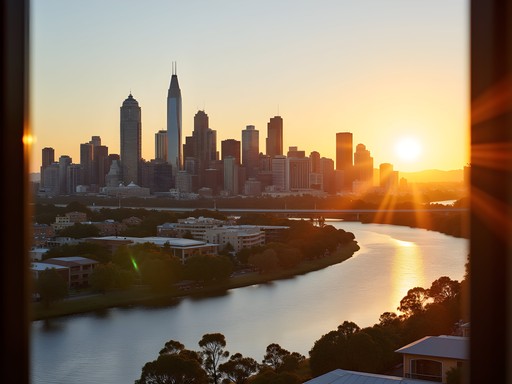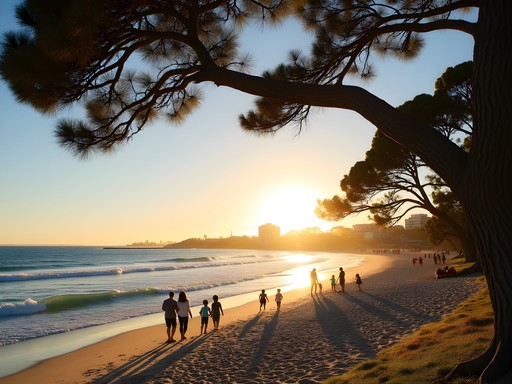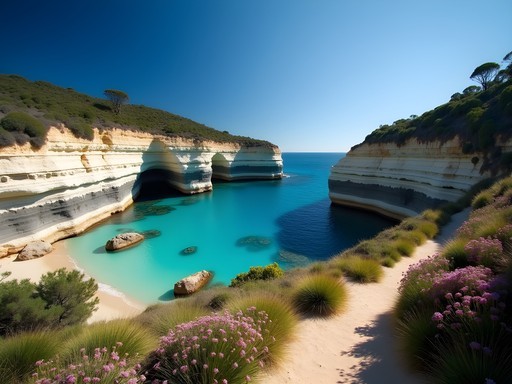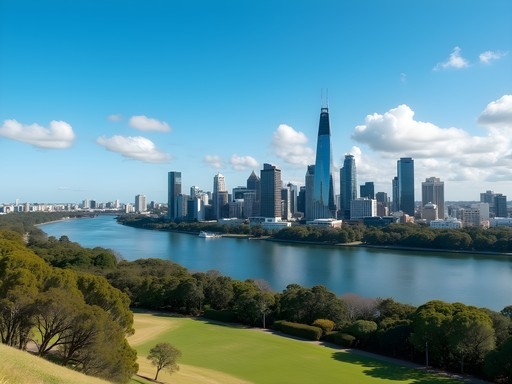Disclosure: This article contains affiliate links. We may earn a commission from purchases at no extra cost to you, which helps our travel content.
As someone who's called Australia home for over two decades, I've explored many corners of this vast country. Yet Perth, with its perfect blend of urban sophistication and raw natural beauty, continues to captivate me like few other places. The capital of Western Australia offers a unique opportunity to experience the quintessential Australian outdoors without venturing too far from creature comforts—something I deeply appreciate when balancing adventure with practicality. During my recent autumn visit, I discovered that Perth's Mediterranean climate creates the perfect backdrop for outdoor exploration, with warm days, cool evenings, and landscapes painted in golden hues. Whether you're traveling with energetic youngsters like my sister's children who joined me on this trip, or seeking cultural connections that remind me of my Mexican upbringing, Perth delivers experiences that resonate across generations and backgrounds.
Swim with Wild Dolphins in Rockingham
Just 45 minutes south of Perth lies an experience that transformed how my family views wildlife encounters. In Rockingham's sheltered bays, you can slip into crystal-clear waters alongside pods of wild bottlenose dolphins—over 200 of them call this coastline home.
What makes this experience extraordinary is that these magnificent creatures aren't trained or fed to encourage interaction; they're genuinely curious about humans. The tour operators I recommend prioritize dolphin welfare, limiting swimming time and participant numbers.
During our visit, my nephew Miguel (who reminds me so much of myself as a child in Mexico City) was initially hesitant to enter the water. The guides were exceptional—patient and encouraging without pushing. Within minutes of seeing the first dolphin approach, his fear transformed into pure wonder.
The tours typically last about half a day, with experienced marine biologists providing fascinating insights into dolphin behavior. You'll spend approximately 1-2 hours in the water, depending on dolphin activity. The operators provide all necessary equipment, including wetsuits (essential even in autumn when the water gets cooler).
After our swim, we enjoyed a simple picnic on the shore, watching the dolphins continue their playful activities in the distance—a memory that remains vivid months later. The perspective gained from being in their environment rather than observing from a boat creates a profound connection with these intelligent mammals.

💡 Pro Tips
- Book at least 2-3 weeks in advance during autumn as this is a popular activity with limited daily spots
- Bring an underwater camera with good waterproofing—I wish I'd had a underwater camera rather than my basic waterproof case
- Take motion sickness medication if you're prone to seasickness, as you'll be on a boat before the swim
Explore Ancient Wonders at Yanchep National Park
Growing up in Mexico City, I developed a deep appreciation for places where cultural heritage and natural beauty intertwine. Yanchep National Park, just 45 minutes north of Perth, offers exactly this harmonious blend.
The park's limestone cave system is nothing short of spectacular. Crystal Cave, with its delicate formations that have taken millennia to create, reminds me of the cenotes I explored as a child in Mexico—though with a distinctly Australian character. The guided tours are informative without being overwhelming, perfect for families with children of various ages.
What truly sets Yanchep apart, however, is the Aboriginal cultural experience. The Whadjuk Noongar people have been connected to this land for thousands of years, and the park offers authentic cultural programs where you can learn about traditional tools, bush tucker (native foods), and dreamtime stories.
During our visit, we participated in a spear-throwing demonstration that had everyone—adults and children alike—fully engaged. The cultural guides share their knowledge with such generosity of spirit that you can't help but feel a deeper connection to the land.
The park is also home to a koala boardwalk where you can observe these iconic Australian animals in their natural habitat. Unlike zoo experiences, seeing koalas draped lazily across eucalyptus trees in an open setting creates a more meaningful wildlife encounter.
After exploring the caves and cultural sites, we enjoyed a picnic by one of the lakes, watching black swans glide across the water—a quintessentially Western Australian scene. For those interested in hiking, the park offers several well-marked trails ranging from 30-minute walks to 3-hour treks.

💡 Pro Tips
- The caves maintain a constant temperature of around 18°C year-round, so bring a light jacket even on warm autumn days
- Book the Aboriginal Experience in advance as sessions can fill quickly, especially during school holidays
- Wear sturdy walking shoes as some cave sections and walking trails can be slippery
Cycle the Swan River Foreshore
One of my favorite ways to experience a new city is on two wheels—it offers the perfect pace to absorb your surroundings while covering significant ground. Perth's extensive cycling network makes this especially enjoyable, with the Swan River foreshore route standing out as the crown jewel.
Rather than rushing through the experience, we rented bicycles for a full day from a shop near Elizabeth Quay. For families with younger children, I recommend opting for a child bike seat or trailer attachment, which most rental shops can provide.
The 10km riverside path from Elizabeth Quay to the charming suburb of South Perth offers breathtaking views of the city skyline reflected in the river's calm waters. What makes this route special is how it balances natural beauty with cultural landmarks. You'll pass through the expansive Kings Park (which deserves its own dedicated visit), the University of Western Australia's picturesque campus, and numerous public art installations that showcase Western Australia's creative spirit.
We timed our ride to include a late afternoon picnic at Point Fraser, where we watched black swans (the emblem of Western Australia) glide across the water as the setting sun painted the city buildings in golden light. This moment—sharing food with loved ones while witnessing such natural beauty—reminded me of evening gatherings in Mexico City's Chapultepec Park from my childhood.
The path is mostly flat and well-maintained, making it suitable for riders of all skill levels. Numerous cafés and rest points along the way allow you to pace the journey according to your family's energy levels. We particularly enjoyed stopping at the small beaches that dot the foreshore, where the children could wade in the shallow waters and collect shells.
For those seeking a longer adventure, the full river loop extends approximately 40km and can be completed in a day by confident cyclists. However, the beauty of this experience is that you can customize it to suit your timeframe and interests.

💡 Pro Tips
- Start early in the morning to enjoy cooler temperatures and less crowded paths, especially during autumn weekends
- Pack plenty of water and snacks, though there are cafés along the route for refueling
- Download the Perth Cycling Map app before setting out—it shows water fountains, restrooms, and points of interest
Discover Rottnest Island by Segway
Having organized numerous corporate events involving Segway tours, I've become somewhat of an enthusiast for these self-balancing vehicles. When I discovered that Rottnest Island—Perth's car-free island paradise—offered guided Segway tours, I knew this would be the perfect way to experience this unique destination.
A 30-minute ferry ride from Fremantle (itself worth exploring), Rottnest Island—or 'Rotto' as locals affectionately call it—is home to pristine beaches, secluded coves, and the famous quokkas, small marsupials known for their seemingly smiling faces.
The Segway tours depart from the main settlement and follow coastal paths that would be challenging to cover on foot in a single day. Our guide, a Rottnest Island authority with 15 years of experience, shared fascinating insights about the island's indigenous history, colonial past as a prison, and current conservation efforts.
The western side of the island features dramatic limestone cliffs and the possibility of whale sightings during migration season (September-November). The eastern shores offer calm, protected bays with water so clear you can see fish darting about without even getting wet.
What makes the Segway experience special is the ability to cover substantial ground (approximately 10km) while still feeling connected to your surroundings—something you don't get from a bus tour. The vehicles themselves are intuitive to operate after a brief training session, and the tour includes several stops at scenic lookouts for photography and wildlife spotting.
One particularly memorable moment came when we encountered a mother quokka with a joey in her pouch near Wadjemup Lighthouse. Our guide explained that autumn is an excellent time for quokka sightings as the moderate temperatures keep them more active during daylight hours.
For those concerned about environmental impact, it's worth noting that the Segways used are eco-friendly with minimal disturbance to the natural habitat—a consideration that aligns with my commitment to responsible tourism practices I've developed through my event coordination work.

💡 Pro Tips
- Book the first morning tour for wildlife sightings and cooler temperatures
- Wear sunscreen and a hat even on cloudy autumn days—the UV index in Western Australia can be deceivingly high
- Bring a small backpack with water and snacks as the tour lasts approximately 2.5 hours
Experience Indigenous Culture on a Derbal Yerrigan River Cruise
My Mexican heritage has instilled in me a profound appreciation for indigenous cultures and their connection to the land. In Perth, I discovered one of the most authentic cultural experiences of my extensive travels: an indigenous-led cruise along the Derbal Yerrigan (Swan River).
Unlike conventional tourist cruises, these cultural journeys are guided by Noongar elders who share dreamtime stories, traditional songs, and deep knowledge about the river's significance to Aboriginal people over thousands of years. The experience begins with a traditional smoking ceremony to cleanse participants and welcome them to Noongar country.
As our small vessel navigated the river, our guide, Uncle Walter, pointed out sites of cultural significance that would be completely overlooked on conventional tours. He explained how the river once flowed differently, how certain landmarks were formed according to dreamtime stories, and how his ancestors used the river's resources sustainably for millennia.
The cruise includes stops at several riverbank locations where participants can see traditional tool-making demonstrations, learn about bush medicine, and taste native foods that have been harvested according to seasonal knowledge. Uncle Walter showed us how to identify plants with medicinal properties—knowledge that has been passed down through countless generations.
What struck me most was how this experience created meaningful cultural exchange rather than performance-based tourism. Questions were encouraged, and the guides seemed genuinely pleased to share their culture with respectful visitors. As someone who has witnessed both thoughtful and problematic approaches to cultural tourism worldwide, I was deeply impressed by the authenticity and educational value of this experience.
The cruise operates with a small group size (maximum 15 participants) to ensure minimal environmental impact and a more intimate experience. This approach aligns perfectly with my belief that the best travel experiences prioritize depth over breadth, fostering genuine connections with people and places.

💡 Pro Tips
- Book well in advance as these specialized cultural cruises operate only a few days per week
- Bring a notebook to record the fascinating information shared—photographs aren't permitted during certain traditional explanations
- Wear comfortable shoes suitable for short walks on natural terrain during shore excursions
Hike Through Ancient Forests in John Forrest National Park
Just 30 minutes east of Perth lies one of Western Australia's oldest national parks—a place where ancient forests, dramatic waterfalls, and abundant wildlife create an immersive bushland experience that feels worlds away from the city.
John Forrest National Park holds special significance for me as it reminds me of the cloud forests I explored as a child during family trips to central Mexico. Though the flora is entirely different, there's a similar sense of timelessness among the towering eucalyptus trees, some of which have stood for centuries.
The Eagle View Trail is the park's premier hiking experience—a moderately challenging 15km loop that showcases the diverse ecosystems within the park. For families with younger children or those seeking a shorter experience, the 2.5km Wildflower Walk offers a more accessible alternative that's particularly spectacular during late winter and spring (though autumn brings its own subtle beauty with softer light filtering through the canopy).
What makes hiking here different from many other national parks is the extraordinary diversity of landscapes packed into a relatively compact area. Within a single morning, we traversed eucalyptus forests, crossed bubbling brooks on stepping stones, stood beneath seasonal waterfalls, and emerged onto granite outcrops offering panoramic views across the coastal plain to Perth's distant skyline.
The park is home to an abundance of wildlife, including western grey kangaroos that are particularly active during the cooler hours of early morning and late afternoon. We spotted several mothers with joeys peering curiously from pouches—a sight that delighted everyone in our group regardless of age.
For those interested in history, the park contains fascinating remnants of Western Australia's first railway tunnel, constructed in the 1890s. This abandoned tunnel now serves as habitat for microbats and creates an atmospheric side trip from the main walking trails.
After our hike, we enjoyed a well-earned lunch at the historic tavern within the park—one of the few national parks in Australia where you can enjoy a proper meal and cold beverage without leaving the natural setting. Sitting on the verandah watching kangaroos graze just meters away perfectly encapsulated the Australian outdoor experience.

💡 Pro Tips
- Start hikes early in the morning to maximize wildlife sightings and avoid midday heat, even in autumn
- Carry at least 2 liters of water per person as the dry Australian bush can be deceptively dehydrating
- Download the park trail maps before visiting as mobile reception can be patchy within the valleys
Final Thoughts
Perth's outdoor offerings extend far beyond these six experiences—from snorkeling at Mettams Pool to stargazing in the Pinnacles Desert, the possibilities seem endless. What makes Perth truly special is how accessible these diverse natural experiences are from a sophisticated urban center. As someone who's balanced two cultural identities throughout my life, I appreciate how Perth similarly balances seemingly contradictory elements: it's simultaneously laid-back yet cosmopolitan, wild yet accessible, ancient yet evolving. Whether you're seeking adventures to bond with family members across generations or solo experiences that connect you with Australia's unique landscapes and cultures, Perth delivers with authenticity and warmth. I encourage you to approach these experiences with an open heart and curious mind—the same qualities that have enriched my own travels across continents. ¡Buen viaje, amigos!
✨ Key Takeaways
- Perth offers exceptional outdoor experiences that are accessible even for families with varying ability levels
- Autumn (March-May) provides ideal conditions for outdoor exploration with mild temperatures and smaller crowds
- Indigenous cultural experiences provide deeper understanding of the landscapes and their significance
- Many activities can be combined in a week-long itinerary with Perth as your base
📋 Practical Information
Best Time to Visit
Autumn (March-May) or Spring (September-November)
Budget Estimate
$1,500-$2,500 for a family of four for one week (excluding flights)
Recommended Duration
5-7 days
Difficulty Level
Moderate

















Comments
Jean Wells
Excellent overview of Perth's outdoor offerings, James. Having explored Perth extensively during my Australia circuit last year, I'd add that the public transportation system makes these activities quite accessible. The CAT buses in Perth CBD are free, and the SmartRider card works seamlessly for reaching places like Fremantle and Cottesloe Beach. For Rottnest Island, I'd recommend taking the earliest ferry to maximize your time before day-trippers arrive. I used my compact binoculars for spotting marine life from the coastal paths - essential for whale watching if you visit between September and December.
vacationpro
We did the public transportation too and it was great! That tip about the early ferry to Rottnest is spot on.
oceanlife
Those Yanchep caves look amazing! Adding to my bucket list.
greenpro
Great post! What's the best time of year to visit Perth for these outdoor activities? I'm planning a trip but trying to avoid extreme heat.
Jean Wells
I've visited Perth in both October and April, and found those shoulder seasons ideal. You get warm days perfect for swimming (around 22-26°C) without the scorching summer heat of December-February. The coastal breeze makes cycling along Swan River particularly pleasant. Spring (September-November) also has the bonus of wildflowers in places like Kings Park.
greenpro
Thanks Jean, that's really helpful! October sounds perfect for my trip.
vacationpro
Just got back from Perth last month and did the dolphin swim in Rockingham - absolutely incredible experience! The dolphins came right up to our group and seemed genuinely curious. Definitely book in advance though, we almost missed out because the tours fill up fast in summer. Rottnest Island was another highlight, but we did bikes instead of Segways. Those quokkas are even cuter in person!
oceanlife
How close did the dolphins get? I've always wanted to do this!
vacationpro
Super close! Like within arm's reach, but of course we weren't allowed to touch them. They swim circles around you - it's magical!
luckyway
Local tip: If you're heading to Rottnest, pack your own lunch. The food options on the island are limited and pricey. The bakery makes great pies though!
starmood
Is the public transport good enough to reach all these places or should I rent a car?
Sarah Powell
Public transport works well for Fremantle and the city center activities, but you'll definitely want a car for Rockingham and Yanchep. The trains are clean and efficient but don't reach all the outer areas mentioned in the post.
Nicole Russell
James, this post is giving me serious nostalgia! I spent a month in Perth last year and would add Kings Park to this list - those treetop walks are MAGICAL at sunset! For anyone heading to Yanchep National Park, don't miss the Aboriginal cultural experience where you can learn about traditional tools and dreamtime stories. I took my compact binoculars which were perfect for spotting birds and koalas in the trees. Perth's outdoor scene is so underrated compared to Australia's east coast - love seeing it get the attention it deserves!
photoclimber
Great post! I'm heading to Perth next month specifically for photography. Which of these spots would you recommend for sunrise/sunset shots? Any specific viewpoints I shouldn't miss?
waveguide
Not the author but Kings Park has incredible sunrise views over the city and river. Worth the early wake-up call!
photoclimber
Thanks! Adding that to my list. Any specific spot in Kings Park?
waveguide
The DNA Tower or the glass bridge walkway. Both give amazing perspectives!
vacationzone
When's the best time of year to do the Segway tour on Rottnest? Worried about it being too hot or rainy.
luckyway
Spring (Sept-Nov) is perfect! Not too hot, wildflowers blooming, less crowded than summer.
coffeebackpacker
Great post! I did the Rottnest Island trip last month and it was the highlight of my Australia journey. One tip: get the earliest ferry possible to beat the crowds. I used my waterproof phone case for taking underwater photos near the beaches - totally worth it for capturing the amazing marine life. The Basin and Parakeet Bay had the clearest water I've ever seen. Oh, and pack plenty of water and sunscreen - the island has limited shade and the sun is intense!
Venture X
Premium card with 2X miles, $300 travel credit, Priority Pass